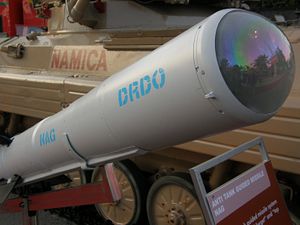The Defense Research and Development Organization (DRDO), the Indian Ministry of Defense’s (MoD) research and development arm, has test fired three Nag third-generation anti-tank guided missiles (ATGM) at the Indian military’s test range at Pokhran in the Thar Desert region in northwestern India on July 7, according to local media reports.
“The missiles were test-fired during both day and night on Sunday during the trials,” DRDO officials were quoted as saying by The Economic Times on July 8. “All three tests were successful.” Additional test firings of the Nag ATGM are planned for this week with final user trials expected to be concluded by the end of this month, after which the weapon system will reportedly be ready for induction by the Indian Army.
The Indian MoD prematurely declared the Nag ready for induction in February 2018, following the completion of test firings against main battle tank targets in desert conditions. However, the Nag’s imagining infrared (IIR) seeker head caused months-long delays as it did not satisfy Indian Army requirements for thermal sensors. It is unclear whether this and other deficiencies of the ATGM have been addressed to date.
Nonetheless, winter user trials of the Nag ATGM were reportedly successfully completed in December 2018. The Indian Army is expected to procure up to 8,000 Nags with an initial order of 500 NAGs to be placed this year pending the successful completion of final user trials. The ATGM is manufactured by India’s sole missile maker, state-owned Bharat Dynamics Limited. To date, no contract between the Indian MoD and the missile producer.
DRDO has been working on the Nag ATGM for more than a decade. Fitted with a tandem warhead, the Nag is an all-weather, fire-and-forget, top attack ATGM with an estimated operational range of between three to seven kilometers. All ground tests of the new ATGM to date have been conducted from an armored combat vehicle. As I reported in 2017:
The Nag Missile Carrier (NAMICA) is an Indian license-produced variant of the Soviet-era BMP-II armored infantry fighting vehicle. NAMICA can launch Nag missiles from a retractable armored launcher that contains four launch tubes (the armored vehicle can carry up to 12 missiles in total) and the guidance package including a thermal imager for target acquisition. The missile’s targeting system is based on visual identification prior to its launch (‘lock-on-before-launch system’).
DRDO has also been working on a man-portable variant of the Nag, designated man-portable anti-tank guided missile (MPATGM) with an engagement range of about 2.5 kilometers.
“The Indian Army leadership has time and again stated that it does not think that the MPATGM will meet the service’s operational requirements and voiced concerns about likely delays in the induction of the new weapon system,” I wrote last month. “However, procuring the MPATGM would fulfill the new Ministry of Defense’s (MoD) strategic partnership (SP) guidelines that aim to facilitate the manufacturing of military hardware locally as part of Prime Minister Narendra Modi’s ‘Make in India’ initiative.”
Additionally, DRDO is trying to field a more advanced air-launched variant of the Nag, the Helina ATGM.

































